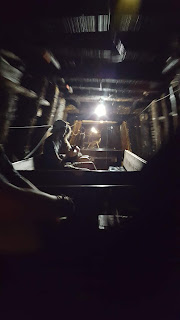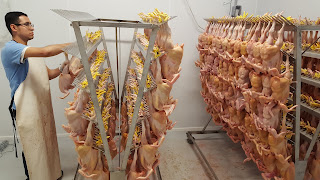"King of the Mountains"
by: friar Rich Rome, OFM Conv.
I don’t think I’ve ever spent a week thinking so much about what is underneath my feet. It's just something that I easily take for granted, right next to the air we breathe.
Even though mining operations ceased decades ago, coal still casts a large shadow in Shamokin. Countless organizations and businesses have the word “anthracite” in their title, an homage to the specific & rare type of hard coal which built the town. Houses and buildings are proudly painted dark gray or black. The main altar, blessed sacrament altar, and ambo at Mother Cabrini Church all sit atop plinths of coal. Gift shops offer pieces as souvenirs (although you can often find a freebie if you root through a gravel pile), but also coal rock candy, coal licorice, and coal bubble gum. The Heritage Restaurant, which is seeking to honor the culture and history of Shamokin, has a beautiful mural painted on the side of it. The title of the work is “When Coal was King.” It’s a common saying throughout coal country; say the phrase, and it is greeted with nods.
But that phrase isn’t quite right. In 1975, the bishops in Appalachia penned a pastoral letter and they specifically addressed “king coal”. The reality is that coal is not king. The "kings" are those who control the coal, and the profit & power that come with it.[1] And the bigger problem is that the "kings" often do not live here. Being removed from the local situations, it is easier to ignore the local plights: underemployment, crime, pollution. The people were dependent on the coal companies; so, when they left, the town collapsed as if the ground beneath it was no longer there.
We took a trip one day to the Anthracite Outdoor Activity Area (AOAA), an outdoor park with several hundred acres of trails for off-roading in jeeps & ATVs. They are trying to both revitalize the economy and protect the mountains so that future generations can enjoy them. The director of the center took us up to the top of the scenic overlook where we could see The Whaleback. At first, it looks like another rolling hill. But then he asked us to look at the hill across from us, the Whaleback, and the hill we were standing on. This entire set of hills is one solid, enormous piece of folded rock called an anticline. It formed when the North and South American plates crashed together to form the Appalachians millions of years ago. Geologists come from all over the world to see and study this feature since it is a rare & large example of a high quality anticline.
I don’t think I’ve ever spent a week thinking so much about what is underneath my feet. It's just something that I easily take for granted, right next to the air we breathe.
Even though mining operations ceased decades ago, coal still casts a large shadow in Shamokin. Countless organizations and businesses have the word “anthracite” in their title, an homage to the specific & rare type of hard coal which built the town. Houses and buildings are proudly painted dark gray or black. The main altar, blessed sacrament altar, and ambo at Mother Cabrini Church all sit atop plinths of coal. Gift shops offer pieces as souvenirs (although you can often find a freebie if you root through a gravel pile), but also coal rock candy, coal licorice, and coal bubble gum. The Heritage Restaurant, which is seeking to honor the culture and history of Shamokin, has a beautiful mural painted on the side of it. The title of the work is “When Coal was King.” It’s a common saying throughout coal country; say the phrase, and it is greeted with nods.
But that phrase isn’t quite right. In 1975, the bishops in Appalachia penned a pastoral letter and they specifically addressed “king coal”. The reality is that coal is not king. The "kings" are those who control the coal, and the profit & power that come with it.[1] And the bigger problem is that the "kings" often do not live here. Being removed from the local situations, it is easier to ignore the local plights: underemployment, crime, pollution. The people were dependent on the coal companies; so, when they left, the town collapsed as if the ground beneath it was no longer there.
We took a trip one day to the Anthracite Outdoor Activity Area (AOAA), an outdoor park with several hundred acres of trails for off-roading in jeeps & ATVs. They are trying to both revitalize the economy and protect the mountains so that future generations can enjoy them. The director of the center took us up to the top of the scenic overlook where we could see The Whaleback. At first, it looks like another rolling hill. But then he asked us to look at the hill across from us, the Whaleback, and the hill we were standing on. This entire set of hills is one solid, enormous piece of folded rock called an anticline. It formed when the North and South American plates crashed together to form the Appalachians millions of years ago. Geologists come from all over the world to see and study this feature since it is a rare & large example of a high quality anticline.
For too
long, the mountains were valued just because they had coal in them. But my experience at the AOAA helped me to
see another reason they should be valued: their beauty and their geological
rarity. Coal is not the king; the
mountains have their own God-given dignity and beauty. But we also aren't the kings; we are the stewards of God’s creation and must render an account of our stewardship, to both God and the generations that follow us. We have to
recognize who is the real King of the Mountains, and respect and take care of
what He has entrusted to us.






very interesting, Rich; thanks!
ReplyDelete